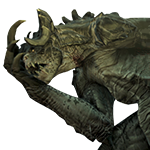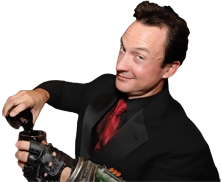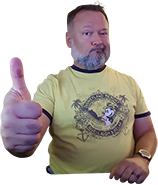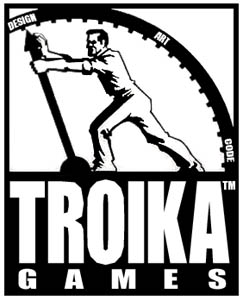The Brief Reign of Troika Games
Celebrating an incredible legacy
The year was 1997, and in the midst of mounting financial troubles, Interplay Productions was somehow still managing to produce a steady stream of hits in Descent II, Redneck Rampage, Carmageddon, MDK - not to mention the soon-to-be released Baldur's Gate and Descent: Freespace. Interplay's back catalogue reads like a "best of" of gaming history, so it is somewhat remarkable that the company only barely averted collapse.
Yet, amongst the all the masterworks of this stunning yet tumultuous period of Interplay's history, few games shine as brightly as Fallout, the landmark CRPG inspired by Interplay's own 1988 CRPG Wasteland. Fallout spawned a franchise that is a household name in gaming today, and though Josh Sawyer and Obsidian helped the series attain what many regard as its pinnacle with Fallout: New Vegas, it's hard to beat the original Fallout for its revolutionary impact on RPG history.
Game development is a team effort of course, but three of the most influential minds behind the Fallout team were Tim Cain, Leonard Boyarsky and Jason D. Anderson. Fallout was just the beginning of what this trio would make together.
Interplay still survives today, but to the staff at Interplay in the late 1997-1998, the situation must have seemed tenuous at best. After some initial work on Fallout 2, the three developers and good friends decided to part ways with Interplay and form their own studio, where they could work how they wanted to. They named this studio Troika Games, a reference to their symbiotic triumvirate.
"It started as a bit of a joke, really. At our last company, people had termed us the Troika because some people felt that Tim had deferred too much "power" over decisions such as art, style, music, and in the end even some design to Jason and me. It was felt that Tim, as producer, should have made all of those type of decisions himself. When we started this company, we decided to call ourselves Troika, but we think of it as referring to the three basic elements necessary for a great game: design, code, and art."
Leonard Boyarsky
speaking to GameSpy in 2000
Troika Games was established on 1st April 1998, and soon began work on their first game, to be published by Sierra Entertainment - a studio facing its own financial problems. Finally, in August 2001, Troika Games entered the stage.
Arcanum: Of Steamworks and Magick Obscura
2001 | Troika Games | Sierra On-Line
Source: GOG.com
Personally, I'm not a fan of steampunk. I find it terribly gimmicky and ridden with tropes. Arcanum, Troika's first game, is nominally "steampunk", but that description alone doesn't do it justice. Arcanum's world is deep, rich and unique, and it isn't overly reliant on the tropes that I feel define typical steampunk. A more accurate description to reflect the game's grounded nature would be "Industrial Revolution fantasy".
Arcanum takes place on the titular world of Arcanum, a land inspired by traditional Tolkienesque fantasy, but thrust forward into an era roughly equivalent to the 19th Century here on Earth. One of the core features of the setting is the conflict between magic and technology, and this conflict dominates the conversations with the locals. Some nations in Arcanum are more conservative, clinging to ancient institutions of royalty (Dernholm) and magic (the elves in Qintarra), while other cities like Tarrant and Ashbury have embraced the technological revolution.
Arcanum is the very definition of a cult classic. It was a financially successful game for Troika, but it didn't exactly achieve runaway sales or critical success. Arcanum's UX is clunky, and the game was riddled with bugs on release. The graphics were dated, and there are plenty of unbalanced loopholes in the mechanics. Yet, in spite of these flaws, Arcanum is remembered fondly by those who played it, and its achievements far outweighed its flaws.
Source: GOG.com
Arcanum presents a completely open, reactive world that demands multiple playthroughs. Your decisions matter, and I don't mean that in the post-Witcher marketing tagline sense. Decisions in Arcanum could truly have enormous effects on the world, and there have been few games since that have matched Arcanum in reactivity and impact of consequence. A commonly cited example is how much intelligence your character has. With high intelligence, your character will be able to debate and outwit the scholars of Arcanum's cities, but if your character has exceedingly low intelligence, they will barely be able to hold a conversation. However, in both examples, you are still able to complete the game. Your path will just be vastly different.
One of the most pleasant surprises I discovered with Arcanum was the way the game subverted the "Chosen One" trope. It is completely unexpected and utterly refreshing, and only one example of the brilliant writing in Arcanum that is always ready to challenge its audience.
One can draw a good deal of parallels between Arcanum and The Outer Worlds, the sci-fi RPG that Tim Cain and Leonard Boyarsky would later develop while at Obsidian. Both contain commentary on the nature of capitalism, labour rights and consumerism, but where The Outer Worlds often pays little more than shallow lip-service, Arcanum offers deep and engaging choices that truly challenge the player about the ethics underpinning the free-market liberalism that forms a cornerstone of modern society. Social commentary in Arcanum feels fresh and brave, so it was surprising to many fans of Arcanum that The Outer Worlds felt uninspired in its societal critiques.
Despite the bugs and archaic presentation, Arcanum sold surprisingly well for the upstart Troika Games;
243,000 units for a profitable $8.8 million in sales. They soon moved on to their next project, a CRPG that is possibly the greatest interpretation of tabletop Dungeons & Dragons ruleset ever produced.
The Temple of Elemental Evil
2003 | Troika Games | Atari
Source: GOG.com
It could be reasonably argued that Dungeons & Dragons was perhaps the greatest influence over the emerging videogame industry of the 70s and 80s. Videogames were the closest thing you could get to the sort of interactive storytelling that tabletop RPGs could provide.
Of the many pre-made adventures published by Gary Gygax's TSR Inc., few were as highly regarded as
T1-4 The Temple of Elemental Evil, and many novice D&D players cut their teeth on at least the first chapter of this adventure,
T1 The Village of Hommlet, which takes place in D&D creator Gary Gygax's very own setting, the world of Greyhawk. The adventure was revisited for the third edition of Dungeons & Dragons in 2001 as
Return to the Temple of Elemental Evil. In tackling a videogame adaptation of this classic D&D module, the team had set themselves a high bar and risked a great deal.
Troika's The Temple of Elemental Evil finally released in September 2003, and critical response was solid - the game still sits at
71 on Metacritic today - and if you dig into the wording of some of those reviews, there are only a handful of issues that hold the game back from achieving a higher score.
Source: GOG.com
As always, it is important to look at the historical context here too - the RPG landscape in 2003 was pretty barren, and those few RPGs that did exist tended away from turn-based combat and crunchy RPG mechanics. Troika's latest release was
both of those things. It was clear that the dev team behind the game were D&D fans, potentially to a fault - The Temple of Elemental Evil remains to this day one of the most faithful adaptations of the tabletop D&D ruleset in gaming history, and for fans of CRPGs who didn't necessarily come from a tabletop gaming background, this may have been a slight obstacle to their appreciation.
The Temple of Elemental Evil also faithfully adapted the sandbox nature of the original module. There is almost no handholding, and there are dozens of ways to be unceremoniously slaughtered or make decisions that lock you out of quests or draw unwanted consequences (if you've got a paladin in your party, don't get into a drinking contest at the tavern...). It is an unforgiving experience at times, and without the camaraderie of a bunch of friends sitting around a table rolling dice.
The Temple of Elemental Evil was also criticised for its lackluster storytelling. In a speech at the
Reboot Develop conference in 2017, Tim Cain himself noted that, after The Temple of Elemental Evil, he came to accept that "I'm not nearly as good a writer as I am a system designer or coder".
Essential viewing for any fan of Tim Cain's work.
The Temple of Elemental Evil was commercially successful, but sales were notably worse than Arcanum, with Troika only moving 128,000 units for $5.2 million,
according to NPD Group. Troika's working income was shrinking, and the challenges for the company were mounting. But they still had one more gem up their sleeve.
Vampire: The Masquerade - Bloodlines
2004 | Troika Games | Activision
Source: GOG.com
Development on Troika's final game began shortly after the release of Arcanum. Doubling down on the success of Arcanum, Troika split their development team into two. One worked on The Temple of Elemental Evil while the other focused on a second RPG, also based on a tabletop system. The tabletop game in question was the World of Darkness RPG by White Wolf Publishing, and the game in question was Vampire: The Masquerade - Bloodlines.
Tim Cain had taken the lead on The Temple of Elemental Evil, so Bloodlines development leadership fell to Leonard Boyarsky and Jason Anderson. The core dev team for Bloodlines was, initially,
only five people, but gradually increased in size over the following years. And they needed all the additional people they could get: Troika was the first external developer to license the brand-new Source Engine from Valve, and they were mostly feeling their way through the dark in attempting to adapt that engine for a first-person RPG.
Troika was an ever-ambitious developer, and no game demonstrates this better than Bloodlines. The team was continuously adding or tweaking features during development, and writer Brian Mitsoda compared the experience to "kitchen sink design". Combine this with a small team using a new engine that lacked a lot of dev tools, and the prospective release date kept creeping further and further into the future.
Source: GOG.com
Once again, Troika was working with a new publisher, Activision, and by 2004, Activision's patience was running thin. The team was told to wrap up development
in a few months. Crunch was already a standard practice at Troika, but this sudden deadline compounded it. As Jason Anderson
recalls:
"It might be better to think of [Bloodlines' development] in terms of non-crunch time. Arcanum had about a year of non-crunch time and Vampire about one or two months. I am not kidding."
Source: GOG.com
Bloodlines finally released in its buggy and unfinished state on 16 November 2004 - the same day as the other flagship Source Engine game, Half-Life 2. It probably comes as no surprise to anyone which game stole the spotlight. Regardless, critical response for Bloodlines was strong, better than either of Troika's previous games. The same criticisms were leveled by all reviewers. Bloodlines was buggy, lacking performance optimisation, and many mechanics were broken or unfinished. Yet the consensus around Bloodlines' flaws was also reflected in its accolades: critics universally praised the writing, calling it witty, intelligent and mature. Reviewers all seemed to agree. Despite its flaws, Bloodlines was an unmissable experience.
For a closer look at the story behind Bloodlines and its tumultuous development and legacy, look no further than the article "
Why Do We Still Remember Vampire: The Masquerade — Bloodlines?" by SUPERJUMP's very own August T.
Unfortunately, this praise didn't translate to sales, which were even worse than that of The Temple of Elemental Evil. Bloodlines only sold 72,000 units, a paltry $3.4 million in sales, hardly the sort of revenue required to sustain a studio of over 30 people. In February 2005, three months after the release of Bloodlines, Troika Games announced their closure.
Working at Troika during those final months must have been a soul-crushing experience. The first layoffs occurred in November 2004, followed by more in December. Troika had attempted to find a publisher for an unnamed post-apocalyptic RPG that Tim Cain later confirmed was intended as a Fallout sequel, but by January 2005, many of the remaining Troika employees
had given up hope and sought work elsewhere. A month later, Troika officially closed its doors.
Troika's "Fallout 3" tech demo
Troika's Legacy
Troika Games only existed for six years, and in that time, they released three RPGs, all of which have become cult classics. In a 2019 poll of the Top 101 PC RPGs of all time, RPG Codex users ranked Troika's games at #4 (Arcanum), #5 (Bloodlines) and #41 (The Temple of Elemental Evil). That is a
stunning track record, and the post-mortem reflections on the legacy of Troika and their games serves to illustrate the fickle nature of the videogame market, and how easy it is for brilliant games to go unnoticed when they don't fit the current market trends or publisher demands.
What makes this output even more stunning is the size of the teams behind the games. Until Troika had secured their first contract with Sierra, the team consisted of only Tim, Leonard and Jason. Even after the additional funding from a publishing deal, the
Arcanum team was only 12 people. And it didn't grow much from there - at the time of the Bloodline's release, Troika Games employed
32 people in total. This may seem like a large team today, but Troika was working without the benefit of established engines like Unity or Unreal - Valve's Source Engine was brand new, while Arcanum and The Temple of Elemental Evil were built from the ground up.
The eponymous "troika" behind the studio went their separate ways. Tim Cain worked at NCSoft on the well-received but ill-fated MMO WildStar, before joining fellow Interplay alumni at Obsidian Entertainment in 2011, where he remains today. There, he lent his knowledge and experience to Pillars of Eternity, Tyranny and The Outer Worlds.
After Troika, Leonard Boyarsky understandably took a year off to recover from "
severe burnout". He returned to game development in 2006, joining Blizzard Entertainment as world designer and writer for Diablo III. Blizzard was Leonard's home until 2016, when he too made the switch to Obsidian Entertainment, joining his old friend Tim Cain and taking on joint-director role with him for The Outer Worlds.
Leonard and Tim (Source: RPGCodex)
Also undoubtedly burnt out, Jason D. Anderson took a break from game development and moved to Phoenix, Arizona with his family. Jason spent his time off renovating his home, and he enjoyed it so much, he soon found himself renovating and selling more homes. His new life flipping real estate was a far cry from his previous work, and refreshingly physical. As Jason recounted to
GameBanshee in 2007:
"Game development is very bad for the body. Sitting on your butt all day and eating out at least one meal a day just doesn't work over the long haul."
Eventually though, the game development itch returned. In 2007 Jason returned to a reinvigorated Interplay, where he worked on what was widely assumed to be a Fallout MMO. Seeking more stability (understandable, after his Troika experience), Jason left Interplay in 2009 and joined Brian Fargo's inXile Entertainment. He contributed to Wasteland 2 while there, before changing again to Turtle Rock Studios in 2011, where he is credited as a contributor on Evolve. However, in 2019, Jason returned to inXile Entertainment, which had been newly acquired by Microsoft.
The closure of Troika clearly had some associated baggage and caused the trio to drift apart somewhat. In the 2007 interview with GameBanshee, Jason stated:
"When Troika fell apart, we drifted a bit. We still talk and get together for lunch every once in a while, but not as much as we used to. I certainly would like to work with them again someday."
Jason received special thanks in the credits for The Outer Worlds ("Jason D. Anderson (our Troika brother)"), and with Microsoft's acquisition of both inXile and Obsidian in 2018, the three friends are now under the same publisher umbrella for the first time since the release of Bloodlines.
Though there are yet to be any announcements regarding future collaboration from the original "troika", many gamers are filled with anticipation for what the future may hold. Tim, Leonard, and Jason have proven time and again that they are a visionary team. With the combination of creative talent at Obsidian and inXile, and Microsoft's formidable financial backing, the legacy of Troika Games has never looked so bright.





































